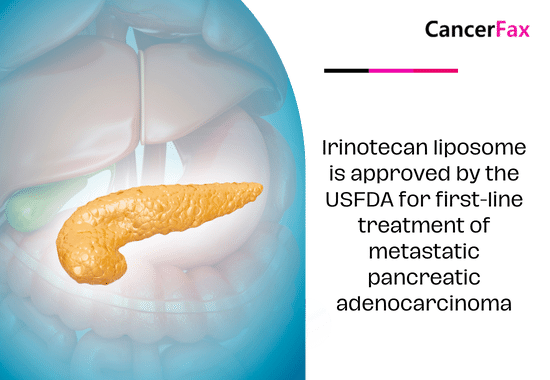The Food and Drug Administration approved irinotecan liposome (Onivyde, Ipsen Biopharmaceuticals, Inc.) with oxaliplatin, fluorouracil, and leucovorin on February 13, 2024, for treating metastatic pancreatic adenocarcinoma as the initial therapy.
NAPOLI 3 (NCT04083235) was a randomized, multicenter, open-label, active-controlled trial with 770 people who had pancreatic adenocarcinoma that had spread to other parts of the body and had never been through chemotherapy in this stage before. It looked at how well the treatment worked. Randomization was categorized based on area, liver metastases, and ECOG performance status. Patients were randomly assigned, in a 1:1 ratio to receive one of the specified therapies.
NALIRIFOX regimen consists of irinotecan liposome at a dosage of 50 mg/m2 administered intravenously over 90 minutes, followed by oxaliplatin at a dosage of 60 mg/m2 administered intravenously over 120 minutes, followed by leucovorin at a dosage of 400 mg/m2 administered intravenously over 30 minutes, followed by fluorouracil at a dosage of 2400 mg/m2 administered intravenously over 46 hours, with this cycle repeated every 2 weeks.
Administer Nab-paclitaxel at a dose of 125 mg/m2 intravenously over 35 minutes, followed by gemcitabine at a dose of 1000 mg/m2 intravenously over 30 minutes on days 1, 8, and 15 of a 28-day cycle.
The primary efficacy measure was overall survival (OS). Other effectiveness criteria were investigator-assessed progression-free survival (PFS) and objective response rate (ORR). NAPOLI 3 showed a substantial increase in overall survival (OS) and progression-free survival (PFS) for the NALIRIFOX group compared to the Gem+NabP group. The median overall survival was 11.1 months (95% CI: 10.0, 12.1) in the NALIRIFOX group and 9.2 months (95% CI: 8.3, 10.6) in the Gem+NabP group. The Hazard Ratio (HR) was 0.84 (95% CI: 0.71, 0.99) with a p-value of 0.0403. The median progression-free survival was 7.4 months (95% CI: 6.0, 7.7) in the NALIRIFOX group and 5.6 months (95% CI: 5.3, 5.8) in the Gem+NabP group (HR 0.70 [95% CI: 0.59, 0.85]; p-value 0.0001). The objective response rate (ORR) was 41.8% (95% CI: 36.8, 46.9) in the NALIRIFOX group and 36.2% (95% CI: 31.4, 41.2) in the Gem+NabP group.
The primary side effects of NALIRIFOX, with a notable difference compared to Gem+NabP, were diarrhea, exhaustion, nausea, vomiting, decreased appetite, gastrointestinal pain, mucosal inflammation, constipation, and decreased weight. The prevalent laboratory abnormalities (≥10% Grade 3 or 4) included reduced neutrophils, potassium, lymphocyte, and hemoglobin levels.
The suggested dosage of irinotecan liposome is 50 mg/m2 given through intravenous infusion lasting 90 minutes every 2 weeks. Administer irinotecan liposome prior to oxaliplatin, fluorouracil, and leucovorin. No specific dosage of irinotecan liposome is advised for patients with blood bilirubin levels beyond the upper limit of normal.

Targeting FGFR4 and CD276 with CAR T-cells demonstrates a strong antitumor impact against children rhabdomyosarcoma
Chimeric antigen receptor (CAR) T-cells that specifically target Fibroblast Growth Factor Receptor 4 (FGFR4), a surface tyrosine receptor that is extensively expressed in rhabdomyosarcoma (RMS), are now undergoing clinical research. However, the effectiveness of these CAR T-cells may be hindered by tumor heterogeneity and inadequate activation. In this study, we present a method to enhance the co-stimulatory and targeting characteristics of a FGFR4 CAR through an optimization process. We substituted the hinge and transmembrane domain of CD8 as well as the 4-1BB co-stimulatory domain with the corresponding domains of CD28. The CARs produced exhibit heightened anti-tumor efficacy in multiple RMS xenograft models, with the exception of the RMS559 cell line, which is known for its aggressive nature.

